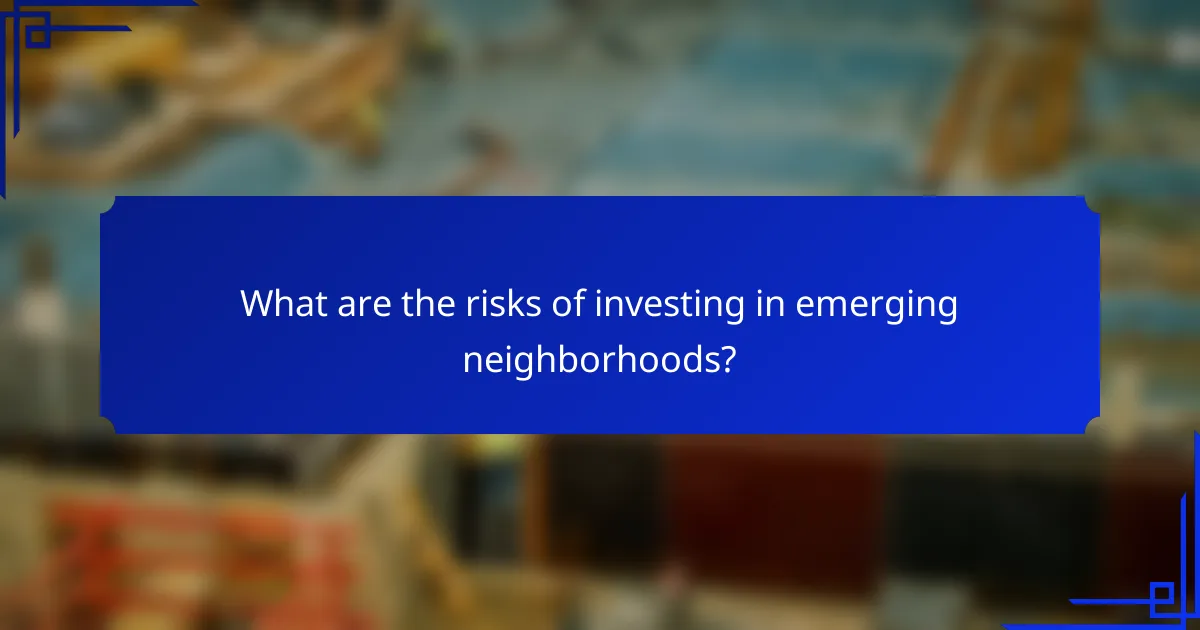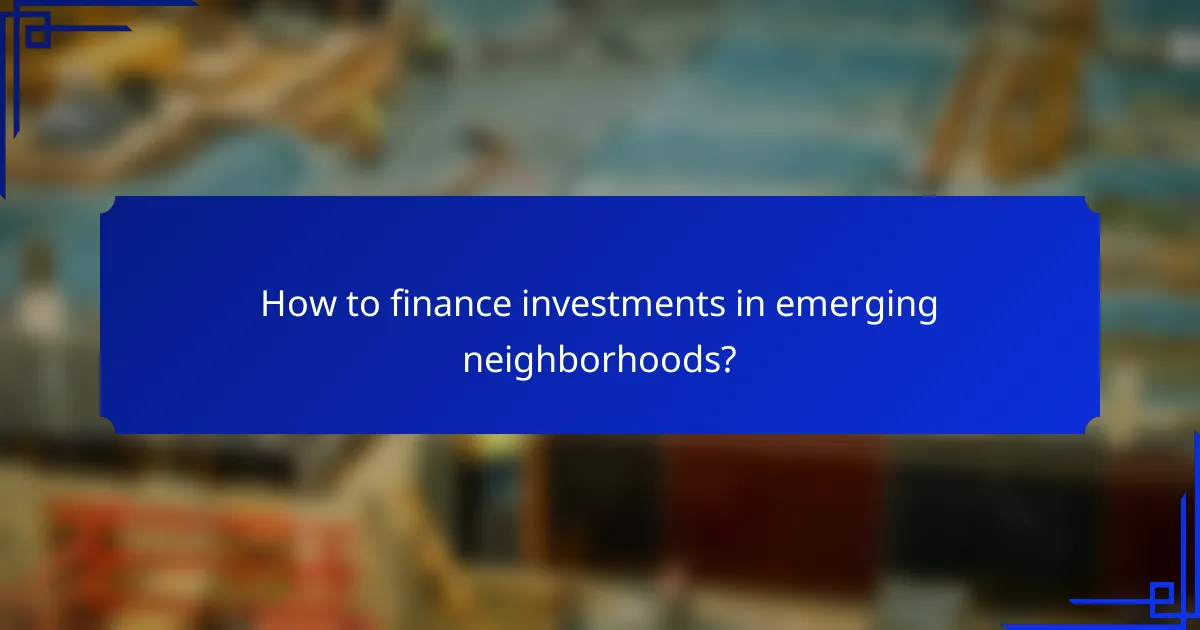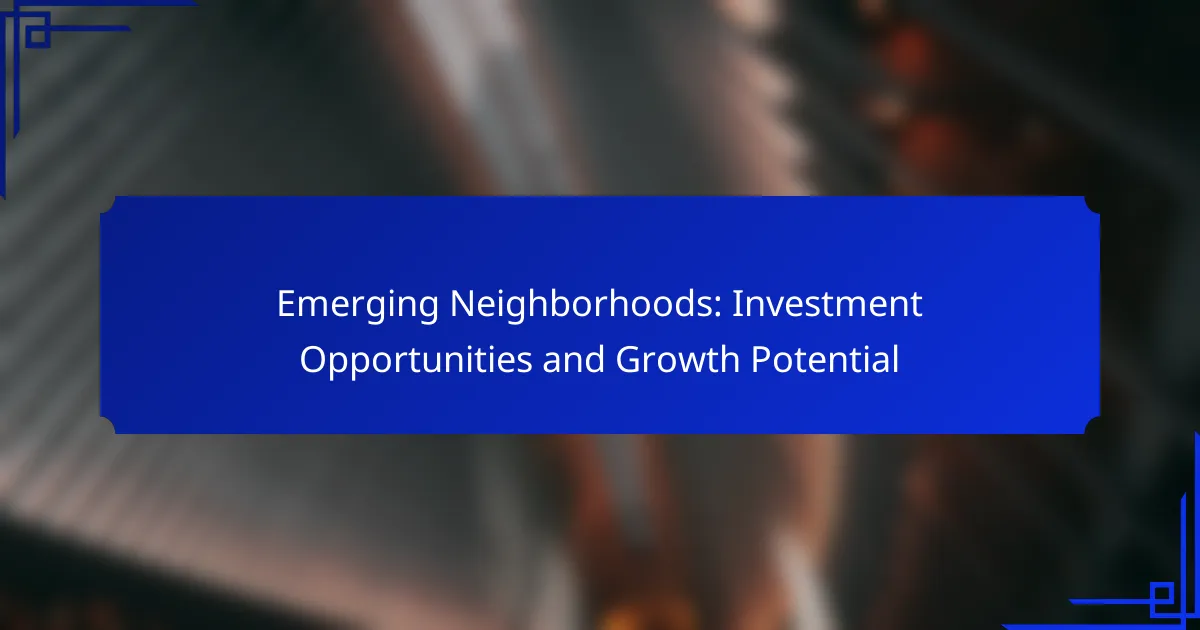Emerging neighborhoods present unique investment opportunities characterized by significant growth potential and relatively affordable property prices. Areas like Downtown Los Angeles, Echo Park, and Inglewood are experiencing increased demand driven by infrastructure development and job market expansion. By analyzing key factors such as local government plans and demographic trends, investors can identify promising markets poised for future success.

What are the best emerging neighborhoods for investment in Los Angeles?
Some of the best emerging neighborhoods for investment in Los Angeles include Downtown Los Angeles, Echo Park, North Hollywood, West Adams, and Inglewood. These areas show significant growth potential due to ongoing development, increasing demand, and relatively affordable property prices compared to more established neighborhoods.
Downtown Los Angeles
Downtown Los Angeles (DTLA) is experiencing a renaissance, with a mix of residential, commercial, and cultural developments. The area has seen a surge in new apartment complexes and luxury condos, driven by an influx of young professionals and creatives. Investors should consider the potential for high rental yields and property appreciation as more businesses and amenities move into the area.
Key attractions like the Staples Center, L.A. Live, and numerous art galleries enhance its appeal. However, potential investors should be mindful of the ongoing construction and urban challenges that can affect property values.
Echo Park
Echo Park is known for its vibrant arts scene and proximity to downtown, making it a hot spot for young families and professionals. The neighborhood offers a mix of charming bungalows and modern developments, appealing to a diverse demographic. Investors can benefit from the area’s growing popularity, which is reflected in rising property values.
With the recent improvements in parks and local businesses, Echo Park is poised for continued growth. However, investors should be aware of the competitive market and the need for thorough research before purchasing properties.
North Hollywood
North Hollywood, particularly the NoHo Arts District, has become a focal point for creative industries and entertainment. The area is undergoing significant revitalization, with new theaters, restaurants, and shops attracting residents. Investors can find opportunities in both residential and commercial real estate, as the demand for housing continues to rise.
Transportation improvements, such as the Metro Red Line, enhance accessibility, making it an attractive option for commuters. Investors should keep an eye on zoning changes and development plans that could impact property values.
West Adams
West Adams is an up-and-coming neighborhood with a rich history and diverse architecture. The area is seeing increased interest from buyers looking for affordable homes near downtown. Investors can find properties at lower price points compared to neighboring areas, with the potential for significant appreciation as the neighborhood gentrifies.
Community initiatives and new businesses are revitalizing the area, but investors should be cautious about the pace of change and potential displacement of long-term residents. Engaging with local community groups can provide valuable insights.
Inglewood
Inglewood is gaining attention due to its proximity to major developments like the SoFi Stadium and the upcoming Clippers arena. The neighborhood offers relatively affordable housing options, making it attractive for first-time homebuyers and investors. The anticipated growth in jobs and entertainment options is likely to drive property values higher.
Investors should consider the potential for short-term rentals, given the influx of visitors for events. However, it’s essential to stay informed about local regulations regarding rental properties to ensure compliance and maximize returns.

What factors drive growth in these neighborhoods?
Growth in emerging neighborhoods is primarily driven by infrastructure development, job market expansion, community amenities, and real estate trends. These elements create a conducive environment for investment and attract new residents and businesses.
Infrastructure development
Infrastructure development is crucial for the growth of emerging neighborhoods. Improvements in transportation, utilities, and public services enhance accessibility and livability, making these areas more attractive to potential residents and investors.
For instance, the construction of new roads, public transit systems, and parks can significantly increase property values. Investors should monitor local government plans for infrastructure projects, as these often signal future growth potential.
Job market expansion
A growing job market is a key indicator of an emerging neighborhood’s potential. When businesses expand or new companies set up operations, they create employment opportunities that draw in residents seeking work.
Areas with diverse job sectors, particularly in technology, healthcare, and education, tend to experience faster growth. Investors should look for neighborhoods with increasing job listings and business development initiatives as indicators of future demand for housing.
Community amenities
Community amenities play a significant role in attracting residents to emerging neighborhoods. Access to quality schools, healthcare facilities, recreational areas, and shopping centers enhances the overall appeal of an area.
Neighborhoods that invest in parks, cultural institutions, and dining options often see increased interest from families and young professionals. Investors should evaluate the availability and quality of these amenities when considering a neighborhood’s growth potential.
Real estate trends
Real estate trends provide insight into the investment potential of emerging neighborhoods. Monitoring property values, rental rates, and occupancy levels can help investors identify areas poised for growth.
For example, neighborhoods experiencing rising home prices and low vacancy rates may indicate strong demand. Investors should analyze local market reports and trends to make informed decisions about where to invest. Additionally, understanding the balance between supply and demand can help avoid over-investing in saturated markets.

How to evaluate investment opportunities in emerging neighborhoods?
Evaluating investment opportunities in emerging neighborhoods involves analyzing various factors that indicate growth potential and market viability. Key considerations include market analysis tools, local government plans, demographic trends, and comparable property assessments.
Market analysis tools
Market analysis tools help investors assess the economic landscape of an emerging neighborhood. These tools often include real estate analytics platforms, local sales data, and trend reports that provide insights into property values and rental rates.
Utilizing software like Zillow, Redfin, or local MLS listings can give a clear picture of market dynamics. Look for neighborhoods with rising property values and increasing demand, which can signal strong investment potential.
Local government plans
Local government plans play a crucial role in shaping the future of emerging neighborhoods. Reviewing city development plans, zoning regulations, and infrastructure projects can reveal how the area is expected to grow and improve over time.
Engaging with local government websites or attending city council meetings can provide valuable information about upcoming initiatives. Areas with planned public transportation expansions or new commercial developments are often more attractive for investment.
Demographic trends
Understanding demographic trends is essential for evaluating investment opportunities. Look for neighborhoods experiencing population growth, increased diversity, or an influx of young professionals, as these factors can drive demand for housing and services.
Analyzing census data and local surveys can help identify shifts in demographics. Areas with a growing population of millennials or families often see rising property values and rental demand, making them prime investment targets.
Comparable property assessments
Comparable property assessments involve analyzing similar properties in the area to gauge market value and investment potential. This process includes examining recent sales, rental rates, and property conditions to determine fair pricing.
Investors should focus on properties that have recently sold or are currently on the market within the same neighborhood. Comparing these properties can provide insights into expected returns and help identify undervalued opportunities. Aim for properties with similar features and locations to ensure accurate comparisons.

What are the risks of investing in emerging neighborhoods?
Investing in emerging neighborhoods carries several risks that can impact potential returns. Key concerns include market volatility, regulatory changes, crime rates, and infrastructure delays, all of which can influence property values and investment stability.
Market volatility
Market volatility refers to the fluctuations in property values that can occur in emerging neighborhoods. These areas often experience rapid changes in demand and supply, which can lead to significant price swings.
Investors should monitor local market trends and economic indicators to gauge stability. Engaging with local real estate professionals can provide insights into the neighborhood’s growth trajectory and potential risks.
Regulatory changes
Regulatory changes can significantly impact investment outcomes in emerging neighborhoods. Zoning laws, property taxes, and development regulations may evolve, affecting property use and value.
Investors should stay informed about local government plans and policies. Attending community meetings or consulting with legal experts can help anticipate changes that could influence investment viability.
Neighborhood crime rates
Crime rates in emerging neighborhoods can pose a risk to property values and rental demand. High crime levels may deter potential buyers and renters, impacting overall investment returns.
Researching crime statistics and trends is essential before investing. Engaging with local law enforcement or community organizations can provide a clearer picture of safety and security in the area.
Infrastructure delays
Infrastructure delays can hinder the growth potential of emerging neighborhoods. Projects such as roads, public transport, and utilities may take longer than expected, affecting accessibility and desirability.
Investors should assess planned infrastructure developments and their timelines. Understanding the local government’s commitment to improving infrastructure can help gauge future property value appreciation.

How to finance investments in emerging neighborhoods?
Financing investments in emerging neighborhoods can be achieved through various methods, including conventional mortgages and hard money loans. Each option has its own advantages and considerations that investors should evaluate based on their financial situation and investment goals.
Conventional mortgages
Conventional mortgages are standard loans offered by banks and credit unions, typically requiring a down payment of around 5% to 20%. These loans are ideal for investors looking for long-term financing with lower interest rates compared to alternative options.
When considering a conventional mortgage, ensure your credit score is strong, as lenders often prefer scores above 620. Additionally, be prepared to provide documentation of your income, assets, and debts to qualify for the best rates.
Hard money loans
Hard money loans are short-term loans secured by real estate, usually provided by private investors or companies. These loans are often easier to obtain than conventional mortgages, making them suitable for investors who need quick access to capital for properties in emerging neighborhoods.
While hard money loans can be funded within days, they typically come with higher interest rates, often ranging from 8% to 15%. Investors should be cautious and have a clear exit strategy, as these loans are usually due within a year or two, requiring a quick turnaround on the investment.
